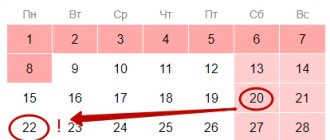The headcount of employees is a type of reporting in which the head of the enterprise himself is interested. With its help, he can get some relief on the tax levied on the enterprise. Of course, this is true if the data provided in these reports gives the right to do so.
What are the differences between average and payroll numbers?
To begin with, it must be said that these rather consonant concepts, such as “average payroll” and “payroll” numbers, are completely different and should not be confused.
To correctly calculate the number (on the payroll) of all employees of the enterprise, we count each employee only once and this is absolutely independent of the factor, whether he worked the entire period or was not present at his workplace for any reason.
And, precisely, based on the above indicator, you will calculate the average number. In order to determine this data for all employees in your company for any one month, you need to proceed as follows: all working organizations on the list are summed up for each day of the period and this indicator is divided by all days of the same period.
The difference is also the following: certain employees must be taken into account in the number on the list, but they do not relate to the concept of the average payroll, for example:
Employees currently on parental leave or maternity leave.
When you need to make a calculation to collect the average number, you will need to take into account that employees who did not work all the time should not be counted in whole units for each day worked, but only in proportion to the time that was worked.
Some categories may be exceptions. These include employees who were granted a reduced work schedule, which is in accordance with the legislation of the Russian Federation. Namely, these include, for example, people with disabilities.
Employees of the company, included as integers
Only a worker who:
- Was on a business trip. The full salary was not retained by the administration.
- Due to poor health, he was not at work (with appropriate confirmation from the hospital).
- Due to overwork or the established schedule of the company, I was on a day off.
- I was on a company-paid (planned) vacation.
- Has the right to work less than full time (for example, disability).
- By decision of the company management, he was transferred to part-time work.
Employees who were on study leave and advanced training paid by the company are also taken into account. Hired (initially) part-time employees.
Any business requires registration. And many people often have a reasonable question: is an individual entrepreneur an individual or a legal entity? After all, individual entrepreneurs are often called individuals or persons without the formation of a legal entity. Which interpretation is correct and how does an individual entrepreneur differ from an LLC?
Read on to learn more about what diversification is and how it is implemented.
You've probably heard about the concept of profitability. But do you know what it includes? Should every enterprise calculate profitability? Here https://businessmonster.ru/buhuchet/raschetyi/rentabelnost-produktsii-formula.html you will find answers to your questions.
Correct and competent calculation of the average number of employees
Suppose you need to calculate the number of employees in an organization for a certain period. For example, the billing period is a month.
We will make the calculation in this way: we will need to add up the number of employees for each day of a certain month according to the list, do not forget to include weekends, and now we divide the amount that is obtained by the sum of days in this billing period.
Initial data
To correctly determine the average headcount, you will need data.
The following may serve as initial data:
- A report card in the established form. Obviously, the average salary must be determined on the basis of the payroll number. And only daily strict accounting will help you determine the correct number from the list. It is precisely in order to accurately take into account the work done by all employees on a daily basis that a document such as a time sheet is needed.
- Production calendar. From the data of such a calendar you will get information about the number of days in the current month, etc.
The concept of a “whole unit”
Just keeping track of employees according to the list is not enough; you need to keep records correctly. And for this, you must know that all employees of the enterprise must be tested once in whole units, both those who actually worked and those who were absent from work.
Exceptions
But there are always exceptions to the rules. Our topic could not do without them. There are workers whom we should not and will not include in the headcount on the list. These include the following:
- working part-time, only externally;
- employees hired under civil contracts;
- employees who do not retain a salary while being sent to other organizations;
- employees attracted by contracts with government organizations;
- employees sent to study with a scholarship and taking time away from work;
- holders of the organization, only those who are not accrued salary.
Payroll
The roster itself includes the widest categories of workers; it literally includes everyone who has a direct relationship with the employer in the form of concluded employment contracts, as well as contracts in civil law form. In this case, we are talking about the provision of certain services or a contract.
It is important to understand that the list of employees of an enterprise in its final reporting should not omit anyone who is engaged in labor activity in one form or another.
The payroll includes all employees hired for a specific job from the very first day until the last. In addition, a mandatory condition for an employee to be included in this list is that he receives a salary. If an individual receives a salary from his employer according to an employment agreement, this means that funds are being spent by the management of the enterprise.
The more monetary remuneration payroll employees receive for work performed, the more noticeable the tax authorities’ relief in relation to the employer should be. For this reason, reporting to the tax office with the most detailed reporting, which sets out the indicators of changes in the payroll number of personnel for the past calendar year, is in the interests of the head of the organization.
From this it can be understood that the payroll must take into account all individuals carrying out work activities. The only exceptions are external part-time workers and women on maternity leave. It is not difficult to understand why they do not turn on.
For example, women on maternity leave, firstly, do not work, and secondly, maternity benefits paid to them come in the form of state benefits. In fact, there is no fact of deduction of expenses from the employer. The same is with part-time workers in external form; they do not participate in the calculation.
Headcount is very important for another reason. It is the basis for calculating and reconciling the average number of employees in an organization. In addition, those persons who work part-time under a specific agreement with the employer are not included in the payroll. But at the same time, this does not in any way apply to those workers who carry out their work activities on a part-time basis in accordance with the labor law.
Formulas for calculating the average number of employees
Below are examples of several formulas that will be needed to calculate the number for different periods of time, for example, for the reporting month, as well as for the quarter and for the year:
Av/list number of employees per month = ∑List/number of days / K days, where
List/number of days – number according to the list of employees for calendar days of a given month;
To days – the sum of those same days of a certain period.
The average number of employees for any quarter is calculated using the following formula:
Average/list number of employees per quarter = ∑Average/list month / 3, where
Average/list of months – the sum of the average number of employees for all 3 months of the reporting quarter.
The average number of employees for the current year is calculated using the following formula:
Average/listed number for the year = ∑ Average/listed month/12, where
Average/list month – the sum of the average number of employees for all 12 months of the reporting year
Categories
All company employees are divided into two main groups according to type of employment. This is another important parameter that is required in order to correctly calculate the headcount. One category is workers, and the other is employees. There are many times more of the former than the latter. So it makes sense to indicate exactly those who are smaller, and all the rest will automatically fall into the category of workers. Thus, employees include all managers (both of the entire enterprise and its individual divisions). This also includes chief accountants, engineers, economists, editors, researchers, electricians, and so on. These are persons falling under category code 1 (all employees are also further divided into 3 groups according to codes). Ordinary engineers, accountants, mechanics, technicians, and so on are already classified under code 2, and secretaries, timekeepers, bookkeepers, and the like are classified under category 3. All of the specified data is needed to ensure that the list of employees of the enterprise is correctly compiled. This is not such an important element, but if filled out incorrectly it will also be considered an error.
Average number of employees per year
| Name of period | Average headcount, people |
| January | 500 |
| February | 503 |
| March | 510 |
| April | 511 |
| May | 511 |
| June | 515 |
| July | 516 |
| August | 517 |
| September | 520 |
| October | 520 |
| November | 521 |
| December | 521 |
| Total: | 6165 |
We determine the average headcount for the year in the following way: we sum up the average headcount for each month of the year and divide this amount by the number of months in the reporting period, that is, by 12 months.
In our example: (500+503+510+511+511+515+516+517+520+520+521+521)/12 = 6165/12=514 people.
Average number of employees for the quarter
| Month | Average headcount, people |
| Month #1 | 500 |
| Month #2 | 503 |
| Month #3 | 510 |
| Total: | 1513 |
We determine the average headcount for any quarter in the following way: we sum up the average headcount for the months of the quarter, in this case, January-March, and divide this amount by 3 (number of months).
In our example: (500+503+510)/3 = 1513/3=504 people.
Responsibility
As with absolutely any report that is sent to government agencies, when drawing up this document you should always take into account the responsibility of the company’s key figures. This is a common practice to ensure that the information provided in the report is as accurate as possible. Thus, the main culprits in the event of a discrepancy are the chief accountant and the head of the department (structure, division, and so on). The payroll compiled by an employee is, of course, an important document, and it must be double-checked by responsible persons.
Average number of employees per month
Let's give an example of calculating the average number of employees for one month (for example, let's take April 2015).
Date Number of employees on the list, people. Not included in the average headcount, people. Included in the average number, people.
1 500 – 500 2 500 – 500 3 501 – 501 4 (weekend) 501 – 501 5 (weekend) 501 – 501 6 512 – 512 7 511 – 511 8 520 – 520 9 520 – 520 10 520 – 520 11 (day off) 520 – 520 12 (weekend) 520 – 520 13 522 – 522 14 522 1 521 15 522 1 521 16 525 1 524 17 525 1 524 18 (weekend) 525 1 524 19 (weekend) 525 1 5 24 20 526 1 525 21 530 2 528 22 531 2 529 23 531 2 529 24 531 2 529 25 (weekend) 531 2 529 26 (weekend) 531 2 529 27 535 3 532 28 535 3 532 29 535 3 532 30 536 3 533 TOTAL: 15613
As can be seen from the table, for all days of this reporting period, the number of employees is 15613, the total number of days in April 2015 is 30, respectively, we get the number of employees that we were looking for, equal to 520 people (15613/30=520.43) . We indicate the number only in whole units.
Report
The report on data on the average headcount is one of the very first of all reports that organizations submit to the territorial tax office. The following reports are submitted to the state statistics bodies: P4 and P4 (NZ).
Where to submit the report and how
A report on information on the average headcount must be submitted to the tax office at the place of registration of your organization or individual entrepreneur. It is provided both on paper in two copies and on a floppy disk. A report such as No. P-4 (NZ) and P4 is submitted to the statistical office. You can submit such a report electronically through a specially installed program, it is very convenient.
Due dates
The maximum deadline for submitting data on the average headcount for the past year is January 20 of the current year according to the approved form. Report P4 for organizations with no more than 15 people is submitted once a quarter, and if the number is more than 15 people, then such a report must be submitted once a month, no later than the 15th day of the month following the reporting one.
Definition
The headcount is the number of all workers of any particular organization. This includes everyone, including those who work in different departments, other structural units, do their work at home, are hired only for a certain time (season), and so on. Absolutely everything is specified as integers. For example, even a person who works only for one season, and not for the whole year, will be counted as a unit on the payroll of the enterprise, and not as 0.25. The exception is those categories of employees who combine work, do not have an employment contract, or groups of people working on the basis of a civil contract.







